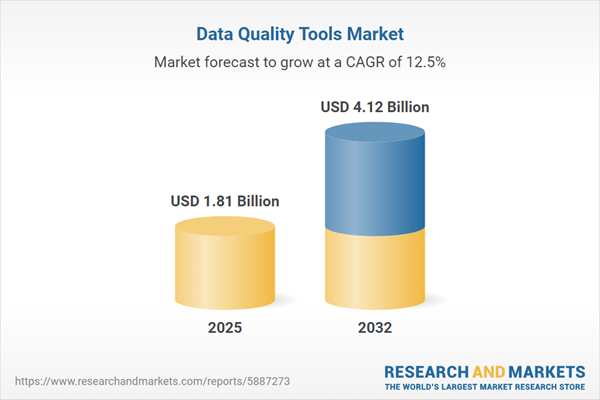Speak directly to the analyst to clarify any post sales queries you may have.
Senior leaders are increasing their reliance on the Data Quality Tools Market to address rising regulatory demands and ensure operational resilience during digital transformation. As organizations face escalating complexity and tighter compliance, advanced data management tools have become central to supporting enterprise risk management and performance objectives.
Market Snapshot: Data Quality Tools Market Growth Outlook
The global Data Quality Tools Market continues robust expansion as enterprises intensify investments in digital resilience. In 2024, market valuation reached USD 1.61 billion, with growth anticipated to USD 4.12 billion by 2032 at a compound annual growth rate of 12.47%. This trajectory is shaped by the drive for operational agility, greater compliance, and secure, automated data management. Decision-makers are leveraging these solutions to enable faster responses to emerging risks, streamline critical processes, and consistently raise performance standards across complex organizations.
Scope & Segmentation of the Data Quality Tools Market
This report delivers a targeted analysis of vital market segments, technological advancements, and geographic trends that influence procurement and strategic direction for senior executives. Each segment enhances a core aspect of enterprise information management and risk control:
- Data Cleansing: Removes inaccuracies and maintains up-to-date records, supporting reliable analytics and enterprise reporting.
- Data Profiling: Provides comprehensive visibility into data assets, strengthening governance and streamlining cross-departmental planning.
- Data Integration: Harmonizes diverse data sources to deliver unified analytics and consistent reporting, improving business decision capabilities.
- Data Quality Monitoring: Automates the detection and handling of data irregularities, which sustains information reliability and lowers manual workload.
- Data Governance: Enforces structured data policies, promoting audit-readiness and transparency throughout the organization.
- Regional Solutions – Americas: Adapts compliance frameworks for the needs of North and Latin American businesses, accommodating complex cross-border data regimes.
- Regional Solutions – Europe, Middle East & Africa: Addresses multijurisdictional regulatory requirements, supporting ongoing enterprise accountability and risk management.
- Regional Solutions – Asia-Pacific: Enables scalable information management to match the high pace of technology adoption across emerging and established markets.
- Technology Adoption: Incorporates artificial intelligence, cloud-native architectures, real-time analytics, container technologies, and advanced metadata management to future-proof operations.
- Leading Vendors: Market players include Informatica LLC, SAP SE, IBM Corporation, Oracle Corporation, SAS Institute Inc., Talend S.A., Experian plc, Precisely Global Inc., TIBCO Software Inc., and Ataccama Corporation.
Key Takeaways for Senior Decision-Makers
- Artificial intelligence elevates data accuracy and speeds up the identification of inconsistencies, increasing operational efficiency for large-scale enterprises.
- Cloud-native infrastructures deliver needed scalability and resilience, granting flexibility when adjusting to changing compliance needs and business priorities.
- Integrated environments empower organizations to anticipate and adapt to compliance challenges and operational risks across business units.
- User-focused modules help teams adopt data quality initiatives faster, accelerating the return on investment and minimizing resistance.
- Strategic partnership with recognized solution providers, along with alignment to industry best practices, augments overall risk management and enhances compliance initiatives.
Assessing the Impact of 2025 US Tariffs
Forthcoming United States tariff measures are motivating enterprises to reevaluate their data platform strategies. Many are moving to cloud-centric solutions to mitigate risks associated with tariff exposure and navigate mounting regulatory complexity. This approach supports operational continuity and strengthens resilience amid ongoing market shifts.
Methodology & Data Sources
This report is grounded in over 30 in-depth expert interviews, supplemented by insights from more than 100 multinational companies. All findings were validated with industry benchmarks and reference materials from top vendors to ensure that recommendations and insights are actionable and reliable for senior leaders.
Why This Report Matters to Data-driven Leaders
- Delivers clarity on which data quality technologies support operational improvement while aligning with enterprise-wide objectives.
- Provides comparative analysis of vendor strengths and compliance practices to support informed, confident strategic procurement activities.
- Strengthens risk oversight by helping organizations update governance controls as regulations evolve and global business conditions change.
Conclusion
Effective management of data quality is essential for mitigating enterprise risk and promoting organizational continuity. This report equips senior leadership teams with guidance to make informed choices for sustainable performance.
Additional Product Information:
- Purchase of this report includes 1 year online access with quarterly updates.
- This report can be updated on request. Please contact our Customer Experience team using the Ask a Question widget on our website.
Table of Contents
3. Executive Summary
4. Market Overview
7. Cumulative Impact of Artificial Intelligence 2025
Companies Mentioned
The companies profiled in this Data Quality Tools market report include:- Informatica LLC
- SAP SE
- International Business Machines Corporation
- Oracle Corporation
- SAS Institute Inc.
- Talend S.A.
- Experian plc
- Precisely Global Inc.
- TIBCO Software Inc.
- Ataccama Corporation
Table Information
| Report Attribute | Details |
|---|---|
| No. of Pages | 189 |
| Published | October 2025 |
| Forecast Period | 2025 - 2032 |
| Estimated Market Value ( USD | $ 1.81 Billion |
| Forecasted Market Value ( USD | $ 4.12 Billion |
| Compound Annual Growth Rate | 12.4% |
| Regions Covered | Global |
| No. of Companies Mentioned | 11 |









